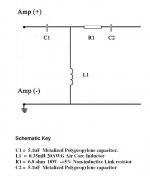Hello all, could someone explain this highpass XO for me. I know its a 3rd order, but what does R1 do. Dont you normally need 2 resisitors for a pad? And why are C1 and C2 the same value? The crossover is from an Adire kit, that I want to use a different tweeter on. The XO freq is 3500hz.
Attachments
The ratio of the caps' value is an indication of the sharpness of the crossover rolloff.
If you're thinking about using this crossover for a different driver, you're heading in a bad direction, potentiometer or no potentiometer. What you need to do is, using the actual impedance and SPL data of the original tweeter, determine what the electrical and acoustic response near the crossover region look like. Then your task is to duplicate it with a different tweeter. Doing it right will not be trivial, but with real data and a good command of a speaker CAD program, it is possible.
If you're thinking about using this crossover for a different driver, you're heading in a bad direction, potentiometer or no potentiometer. What you need to do is, using the actual impedance and SPL data of the original tweeter, determine what the electrical and acoustic response near the crossover region look like. Then your task is to duplicate it with a different tweeter. Doing it right will not be trivial, but with real data and a good command of a speaker CAD program, it is possible.
Unless R1 is incorporated in a corrected Rtot for the load, it will also modify the slope of this HP section.
Without knowing the details of rest of the circuit, it is next to impossible to know the exact purpose of R1.
If the sole purpose was to reduce the level of the tweeter, there should be an R2 to ground, to complete an L-pad.
Without knowing the details of rest of the circuit, it is next to impossible to know the exact purpose of R1.
If the sole purpose was to reduce the level of the tweeter, there should be an R2 to ground, to complete an L-pad.
that's exactly what i mean....
The filter is undoubtably 3rd order, but R1 will also modify the stop band curve, or the "knee" if you like, so unless you know the details of the total contraption, or more exactly the designers purpose, there is several options to the function of R1
The filter is undoubtably 3rd order, but R1 will also modify the stop band curve, or the "knee" if you like, so unless you know the details of the total contraption, or more exactly the designers purpose, there is several options to the function of R1
- Status
- This old topic is closed. If you want to reopen this topic, contact a moderator using the "Report Post" button.
- Home
- Loudspeakers
- Multi-Way
- Explain this crossover
